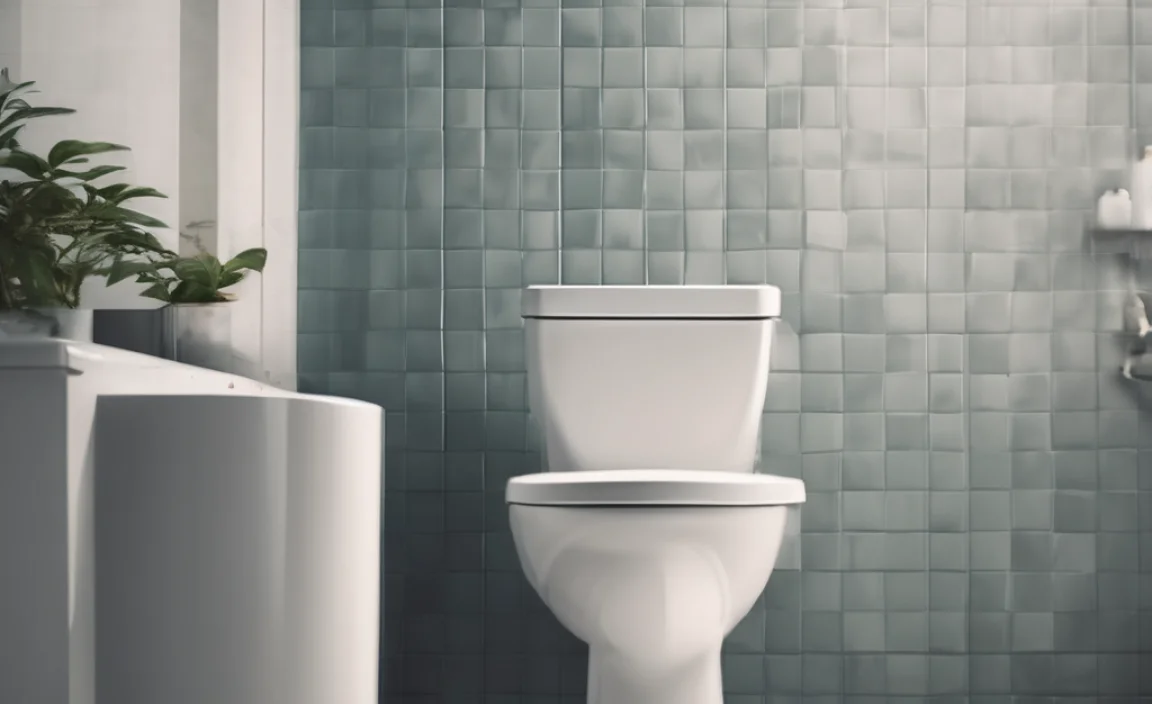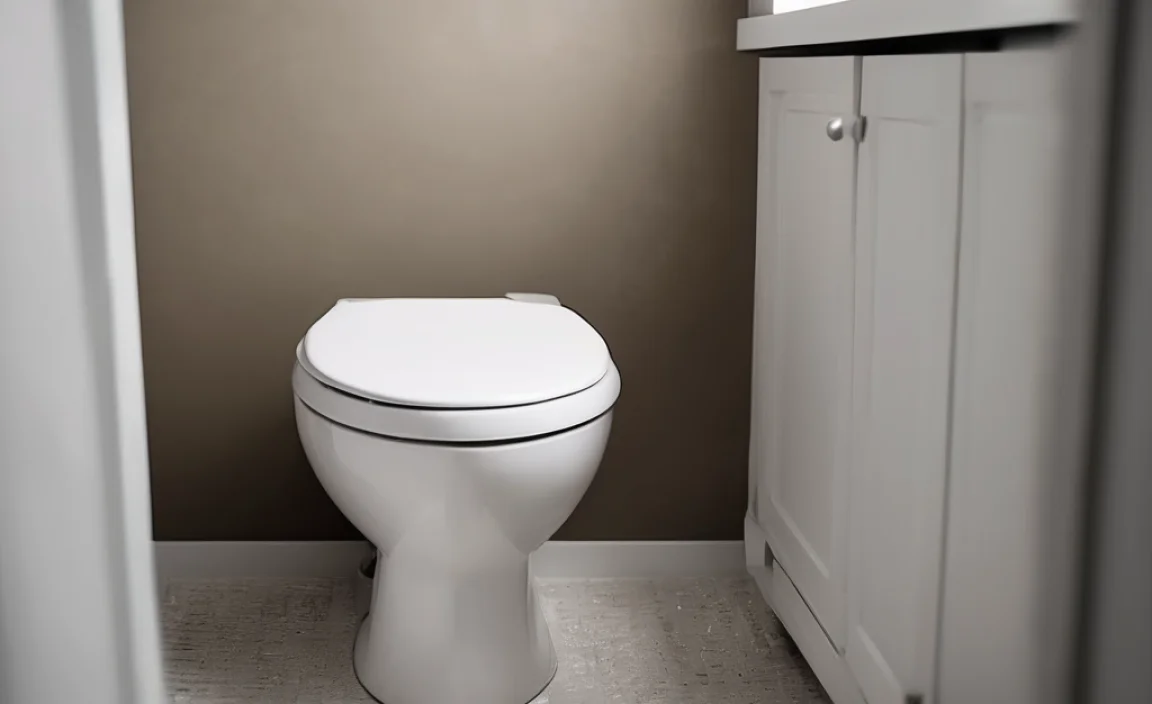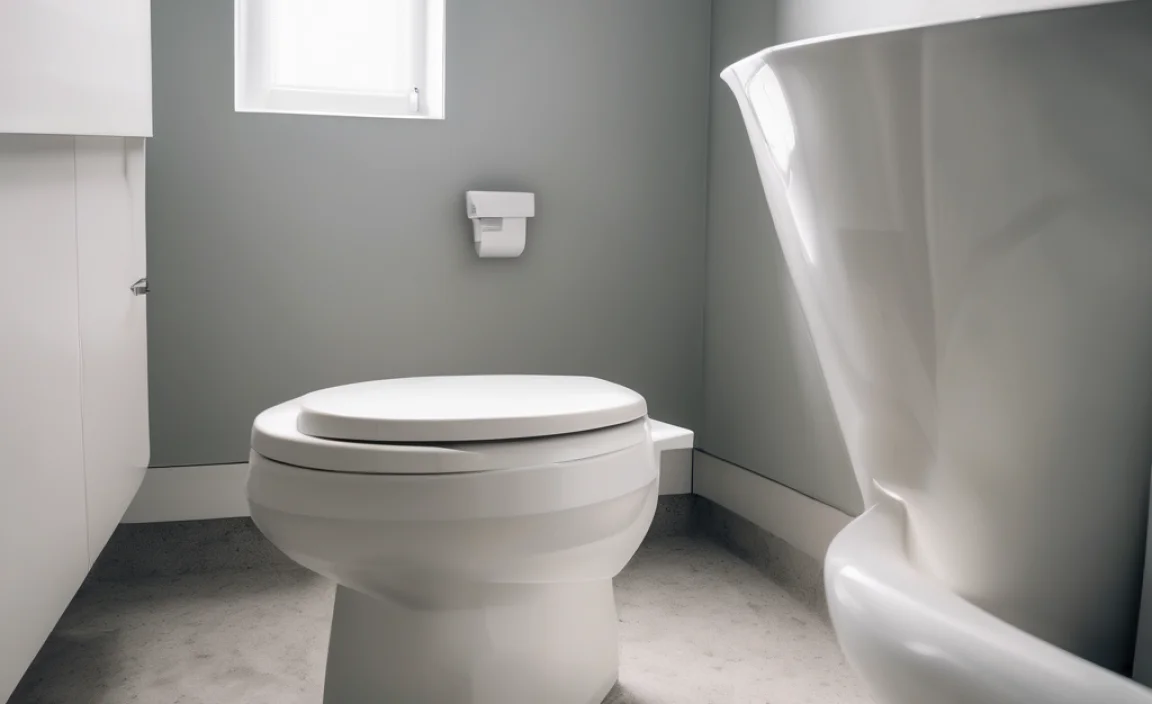Why does your toilet get moldy? It’s usually because of moisture, poor ventilation, and organic matter for the mold to feed on. Fix leaky pipes and clean regularly with mold-killing products. Increase airflow by opening windows or using a bathroom fan. This will prevent mold from coming back.
Is your toilet bowl sporting some unwelcome mold? Don’t worry; you’re not alone! It’s a pretty common problem. Mold loves damp places, and your toilet is the perfect spot. It can be frustrating to deal with, but don’t stress. We’ll walk you through why it happens and how to stop it. You’ll learn simple steps to keep your toilet mold-free for good. Let’s get started!
Understanding Why Mold Grows in Your Toilet

Mold needs a few things to thrive. Let’s break down why your toilet is such a great place for it:
Moisture: The Main Culprit
Mold loves water. Your toilet is constantly exposed to moisture, making it a prime spot for mold growth. Here’s why:
- Condensation: Cold water in the toilet bowl can cause condensation on the outside of the tank and bowl, especially in humid weather.
- Leaks: Even small leaks from the tank or around the base of the toilet can provide enough moisture for mold to grow.
- Splashing: Each flush can cause water to splash onto the surrounding surfaces, creating damp spots.
Poor Ventilation: Trapping Moisture
Bathrooms often lack good airflow. This traps moisture, creating a humid environment that mold loves. Think about it:
- Steam: Hot showers and baths create a lot of steam.
- Lack of Airflow: Without good ventilation, this moisture lingers, encouraging mold growth.
Organic Matter: Mold’s Food Source
Mold needs something to eat. In your toilet, it can find food in:
- Soap Scum: Residue from soaps and cleaning products can build up.
- Body Oils: These can transfer to surfaces during use.
- Dust and Dirt: These particles settle and provide nutrients for mold.
The Role of Temperature
Mold thrives in warm environments. Bathrooms tend to be warmer than other rooms in the house, especially after a hot shower. This warmth speeds up mold growth.
Identifying Different Types of Mold in Your Toilet

Not all mold is the same. Here are a few common types you might find in your toilet:
- Black Mold (Stachybotrys): This is one of the most talked-about molds. It’s dark green or black and can be toxic.
- Pink Mold (Serratia marcescens): Technically, this isn’t mold, but a bacteria. It appears as a pink or orange slimy film.
- Green Mold (Cladosporium): This mold is usually green or black and can grow on many surfaces.
- Blue Mold (Penicillium): Often bluish-green, this mold is common in damp areas.
While some molds are harmless, others can cause health problems. It’s always best to remove mold as soon as you see it.
Health Risks Associated with Mold Exposure

Mold can cause a range of health issues, especially for people with allergies or asthma. Here’s what you should know:
- Allergic Reactions: Mold can trigger sneezing, runny nose, itchy eyes, and skin rashes.
- Respiratory Problems: Exposure to mold can worsen asthma and cause coughing, wheezing, and difficulty breathing.
- Infections: Some molds can cause infections, particularly in people with weakened immune systems.
- Irritation: Mold can irritate the eyes, skin, nose, and throat.
If you suspect you’re having a reaction to mold, see a doctor. It’s important to address mold problems quickly to protect your health.
Step-by-Step Guide to Removing Mold from Your Toilet
Ready to get rid of that mold? Here’s a simple, step-by-step guide:
Step 1: Gather Your Supplies
First, get everything you need:
- Gloves: Protect your hands.
- Mask: Avoid breathing in mold spores.
- Scrub Brush: A toilet brush or stiff-bristled brush works well.
- Spray Bottle: For your cleaning solution.
- Cleaning Solution: Choose from the options below.
- Old Rags or Sponges: For wiping surfaces.
Step 2: Choose Your Cleaning Solution
You have several options. Here are a few effective ones:
- Bleach Solution: Mix 1 part bleach with 10 parts water. Be careful, as bleach can damage some surfaces.
- Vinegar: White vinegar is a natural and effective mold killer. Use it undiluted.
- Baking Soda: Make a paste with water or mix it with vinegar for extra cleaning power.
- Commercial Mold Remover: Follow the instructions on the product label.
Step 3: Apply the Cleaning Solution
Now, let’s get cleaning:
- Spray: Spray the moldy areas with your chosen cleaning solution.
- Soak: Let the solution sit for 10-15 minutes to kill the mold.
- Scrub: Use the scrub brush to scrub away the mold.
- Rinse: Flush the toilet and rinse the cleaned areas with water.
- Wipe: Use a rag or sponge to wipe down any remaining residue.
Step 4: Dry the Area
Mold loves moisture, so drying is key:
- Ventilate: Open a window or turn on the bathroom fan to help dry the area.
- Wipe Down: Use a clean, dry cloth to wipe down all surfaces.
Step 5: Repeat if Necessary
For stubborn mold, you might need to repeat the cleaning process. Don’t give up!
Natural Mold Removal Methods
If you prefer to avoid harsh chemicals, here are some natural ways to remove mold:
- Vinegar: Spray undiluted white vinegar on the mold, let it sit for an hour, then scrub and rinse.
- Baking Soda: Make a paste with water, apply to the mold, let it dry, then scrub and rinse.
- Tea Tree Oil: Mix 1 teaspoon of tea tree oil with 1 cup of water, spray on the mold, and let it sit for an hour before wiping. No rinsing needed.
- Hydrogen Peroxide: Spray a 3% solution of hydrogen peroxide on the mold, let it sit for 10 minutes, then scrub and rinse.
These methods are gentler and safer, but they might require more effort for heavy mold growth.
Preventing Mold Growth in Your Toilet
The best way to deal with mold is to stop it from growing in the first place. Here’s how:
Improve Ventilation
Good airflow is essential. Here’s what you can do:
- Use the Bathroom Fan: Always turn on the fan when showering or bathing. Leave it on for 15-20 minutes afterward to remove excess moisture.
- Open Windows: If you have a window in your bathroom, open it regularly to air out the room.
- Dehumidifier: Consider using a dehumidifier to reduce moisture levels in your bathroom.
Regular Cleaning
Regular cleaning prevents mold from getting a foothold. Aim to clean your toilet at least once a week:
- Toilet Bowl Cleaner: Use a toilet bowl cleaner to kill germs and prevent mold growth.
- Wipe Down Surfaces: Regularly wipe down the outside of the toilet, including the tank and base.
- Clean Under the Rim: Mold often grows under the rim of the toilet bowl, so be sure to clean there.
Fix Leaks Promptly
Even small leaks can cause mold. Check regularly for leaks and fix them right away:
- Check the Tank: Look for leaks around the tank and the connections to the water supply.
- Check the Base: Inspect the base of the toilet for water pooling or dampness.
- Replace Worn Parts: Replace any worn or damaged parts, such as flappers or fill valves.
Use Mold-Resistant Products
When renovating or redecorating your bathroom, consider using mold-resistant products:
- Mold-Resistant Paint: Use paint that contains mildewcides to prevent mold growth on walls and ceilings.
- Mold-Resistant Caulk: Use caulk that is formulated to resist mold and mildew in areas prone to moisture.
DIY Solutions vs. Professional Mold Removal
For small mold problems, DIY solutions can be effective. But for larger infestations, you might need professional help.
When to DIY
DIY mold removal is suitable if:
- The mold covers a small area: Less than 10 square feet.
- The mold is on surfaces you can easily clean: Like the toilet bowl or surrounding tiles.
- You don’t have health issues: That could be worsened by mold exposure.
When to Call a Professional
Call a professional mold removal service if:
- The mold covers a large area: More than 10 square feet.
- The mold is in hard-to-reach places: Like inside walls or under floors.
- You have health problems: That could be worsened by mold exposure.
- You’ve tried DIY methods: And they haven’t worked.
Professionals have the tools and expertise to safely and effectively remove mold, especially in severe cases.
Choosing the Right Cleaning Products
With so many cleaning products on the market, it can be hard to choose the right one. Here’s a quick guide:
| Product | Pros | Cons | Best For |
|---|---|---|---|
| Bleach Solution | Effective, readily available, inexpensive | Strong odor, can damage surfaces, toxic | Tough mold stains, non-porous surfaces |
| Vinegar | Natural, safe, effective | Strong odor, may not kill all mold species | Mild mold, everyday cleaning |
| Baking Soda | Natural, gentle, deodorizing | Requires scrubbing, may not kill all mold | Light cleaning, deodorizing |
| Commercial Mold Remover | Specially formulated, effective | Can be expensive, may contain harsh chemicals | Heavy mold infestations, specific surfaces |
| Tea Tree Oil | Natural, antifungal, pleasant scent | Can be expensive, requires dilution | Mild mold, natural cleaning |
Always read and follow the instructions on the product label. And remember to test any cleaning solution in an inconspicuous area first to make sure it doesn’t damage the surface.
Maintaining a Mold-Free Toilet: Long-Term Strategies
Keeping your toilet mold-free is an ongoing process. Here are some long-term strategies to help:
- Regular Inspections: Check your toilet and bathroom regularly for signs of mold or leaks.
- Proper Ventilation: Always use the bathroom fan or open a window when showering or bathing.
- Consistent Cleaning: Clean your toilet and bathroom at least once a week.
- Address Moisture Issues: Fix any leaks or plumbing problems promptly.
- Use Mold-Resistant Products: When possible, use mold-resistant paint, caulk, and other products.
By following these strategies, you can keep your toilet and bathroom clean, healthy, and mold-free.
FAQ About Mold in Toilets
Here are some frequently asked questions about mold in toilets:
Why does mold grow so quickly in the toilet?
Mold grows quickly because toilets are damp, warm, and often poorly ventilated. These conditions are perfect for mold to thrive.
Is pink mold in the toilet dangerous?
Pink mold, or Serratia marcescens, isn’t technically mold but a bacteria. While it’s usually not harmful, it can cause infections in some cases, so it’s best to clean it away.
Can I use bleach to kill mold in the toilet?
Yes, bleach can kill mold. Mix 1 part bleach with 10 parts water, apply it to the moldy area, let it sit for 10-15 minutes, then scrub and rinse.
How often should I clean my toilet to prevent mold?
Clean your toilet at least once a week to prevent mold growth. Regular cleaning removes the organic matter that mold feeds on.
What are some signs of hidden mold in the bathroom?
Signs of hidden mold include a musty odor, water stains on walls or ceilings, and peeling paint or wallpaper.
Can mold in the toilet make me sick?
Yes, mold can cause allergic reactions, respiratory problems, and other health issues, especially in people with allergies or asthma.
Is it safe to mix bleach and vinegar to clean mold?
No, never mix bleach and vinegar. This combination creates toxic fumes that can be dangerous to your health.
Conclusion
Dealing with mold in your toilet can be a bit of a nuisance, but it’s definitely manageable. By understanding why mold grows, identifying the type of mold you’re dealing with, and following our simple steps for removal and prevention, you can keep your toilet clean and healthy. Remember, regular cleaning, good ventilation, and prompt leak repairs are your best defenses. For larger mold problems, don’t hesitate to call in a professional. With a little effort, you can maintain a mold-free bathroom and enjoy a cleaner, healthier home. You’ve got this!
